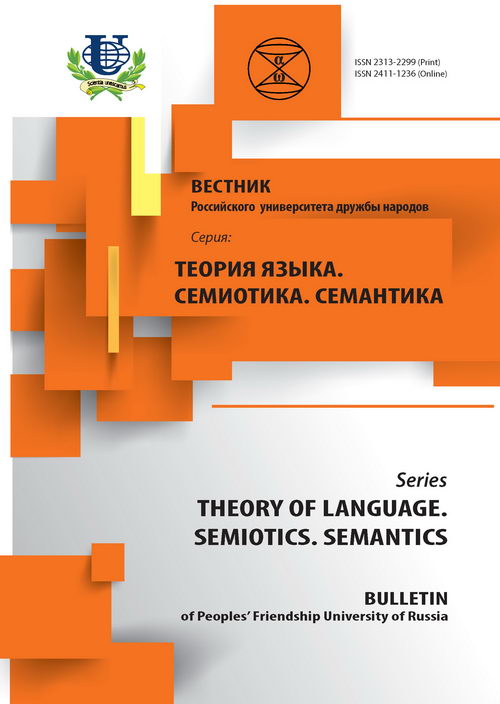No 1 (2011)
- Year: 2011
- Articles: 14
- URL: https://journals.rudn.ru/semiotics-semantics/issue/view/450
ARTICLES
Where is the centre of the profound Euro-Asian culture: The Euro-Asian ideology in the light of achievements of the systemic language typology
RUDN Journal of Language Studies, Semiotics and Semantics. 2011;(1):5-14
 5-14
5-14


Modelling of the fragment activity in the case-preposition semantics (syntactic constructions in the Russian, English and Italian languages)
Abstract
Cast-prepositional semantics is treated in the cognitive aspect. The fragment activity/ while being emphasized in structurally different languages by means of prepositions and case forms, allows to reveal both peculiar and universal features of human perception proceeding from specific national worldviews.
RUDN Journal of Language Studies, Semiotics and Semantics. 2011;(1):15-21
 15-21
15-21


Consideration of semantic and structural similarities and differences of the English somatic phraseological units while translating them into Russian
Abstract
The subject of the research is the comparison of English and Russian phraseological units which include partonyms of the somatism HEAD. Somatic phraseological units are connected as synonyms, antonyms, homonyms and polysemantic words. Proceeding from complete identity, partial identity and complete difference in both English and Russian we formed three correlating groups of phraseological units.
RUDN Journal of Language Studies, Semiotics and Semantics. 2011;(1):22-32
 22-32
22-32


On syntactic and semantic decomposition of an idio
Abstract
The metaphoric nature of an idiom accounts the unpredictability of the global meaning of the whole from, the literal meanings of the constituent parts and results in its usage as a lexical expressive means in fiction. Syntactic and semantic flexibility of idioms is confirmed by various kinds of their deformations.
RUDN Journal of Language Studies, Semiotics and Semantics. 2011;(1):33-37
 33-37
33-37


Semantics of the names of abstract concreteness in the Russian language system
Abstract
In the article nominative properties, semantics and paradigmatic organization of names of age in Russian are analyzed. The analysis purpose is to establish the specificity of the nomination of the graded denotate in the terminology system and common-literary language, revealing of structural-semantic features of the given lexical sphere.
RUDN Journal of Language Studies, Semiotics and Semantics. 2011;(1):38-45
 38-45
38-45


Polysemy of loanwords (as an example of the originally Arabic lexical units)
Abstract
Language lexical system is the most vulnerable for loanwords as this is the regular means to enlarge vocabulary. Getting into a new language environment, a loanword used to be adopted by all possible means - from phonetics to syntax - and inevitably obtains a number of new meanings. Thus it makes a full-featured language unit.
RUDN Journal of Language Studies, Semiotics and Semantics. 2011;(1):46-49
 46-49
46-49


Semiotic characteristics of the Internet media-texts
Abstract
Range expansion of the semiotics codes participating in formation of new type of texts - mediatexts - has led to the necessity of researching the texts' polycode structure in an epoch of the postindustrial society, most brightly represented in the Internet, in particular, in the Internet advertising.
RUDN Journal of Language Studies, Semiotics and Semantics. 2011;(1):50-58
 50-58
50-58


Semantico-semiotic aspects of the diplomatic discourse
Abstract
Linguistic research of different kinds of an institutional discourse is determined by accent on studying of communication ontogenesis and searching of universal bases of speech interaction. The diplomatic discourse possesses its individual linguistic and semiotics characteristics distinguishing it among other discourse kinds.
RUDN Journal of Language Studies, Semiotics and Semantics. 2011;(1):59-66
 59-66
59-66


The place and role of language in disapora formation
Abstract
The goal of the present article is an attempt to define the place of the national (mother) tongue in the formation and safeguard of diasporas. To achieve the set goal the author offers an explanation and a more precise definition of diasporas phenomenon which demands a list of key characteristics of classical and modern diasporas. The following analysis results in the statement of the fact that none of the given characteristics includes the mother tongue as a necessary precondition of diasporas formation.
RUDN Journal of Language Studies, Semiotics and Semantics. 2011;(1):67-74
 67-74
67-74


 75-81
75-81


Chinese cinema and films: Organizational and lingvo-methodical bases in practice of teaching modern Chinese (First article)
Abstract
The article deals with the problems of Chinese language peculiarities and the elaboration of teaching methods and programmes including Chinese films and cinema language presentation. Unique authors' methods are developed proceeding from specific usage of film and cinema materials presentation.
RUDN Journal of Language Studies, Semiotics and Semantics. 2011;(1):82-87
 82-87
82-87


Specifics of training Russian students to cross-cultural interaction in auditorium and non-auditorium activity
Abstract
Mastering a foreign language supposes the knowledge of cultural and historic traditions and skills to take into consideration conditions of communication/ National mentality, worldview and rules of communicative behavior are elaborated not just in course of routine auditorium activities, but above all in different situational and language games, reflecting typical interactive situations in course of communication.
RUDN Journal of Language Studies, Semiotics and Semantics. 2011;(1):88-91
 88-91
88-91


Minority languages categorization: Multidisciplinary approach to the Russian terminology, Bordeaux, France. December, 9-10th, 2010
RUDN Journal of Language Studies, Semiotics and Semantics. 2011;(1):92-94
 92-94
92-94


Our authors
RUDN Journal of Language Studies, Semiotics and Semantics. 2011;(1):95-96
 95-96
95-96
















